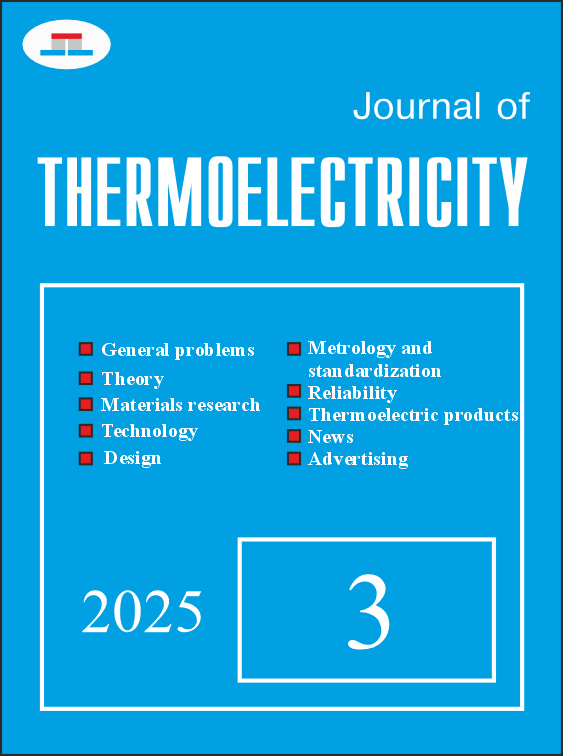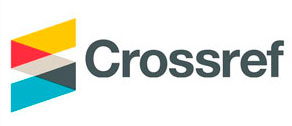Generalized Parameter and Compatibility factor of Thermoelectric n-SixGe1-x
DOI:
https://doi.org/10.63527/1607-8829-2025-3-37-44Abstract
The dependence of the maximum of the figure of merit (ZT)max of the SixGe1-x alloy on the generalized parameter of material B* is investigated. A formula is used to calculate the values of B*, which contains the quantities of band gap, specific electrical conductivity, scaled parameter and lattice thermal conductivity: B* ≅ 7.755·10-4Eg kL-1. This formula is derived from the combination of the formulas known from the literature that relate the thermoelectric parameters - mobility, effective mass and weighted mobility of charge carriers. This formula no longer includes effective mass, mobility and temperature - these parameters are replaced by specific electrical conductivity and the Seebeck coefficient. Dependence (ZT)max – B* is constructed. By calculating the generalized parameter, you can approximately estimate the maximum value of the figure of merit for almost any thermoelectric. The compatibility factor of SixGe1-x has been determined. The possibility of creating segmented thermogenerators based on this material in combination with YbMg1.8Zn0.05Bi1.98, CuAl0.8Fe0.2O2 and Cu1.98S is indicated.References
1. Rosi F.D. (1968). Thermoelectricity and thermoelectric power generation. Solid State Electronics, 11(9), 849-868.
2. de Winter F. (1972). Xenon-filled silicon germanium thermoelectric generators. JPL Technical Review, 2(3), 22-31.
3. Cook B. (2022). Silicon-germanoim: The legacy lives on. Energies 15(8), 2957.
4. Barbakadze K., Bokuchava G., Isakadze Z. (2022). High temperature thermoelewctricgenrator based on SiGe alloy. Sci J LEPL – Agmashenebeli National Defence Academy of Georgia, 47-50.
5. Schwinge C., Kühnel K., Emara J. (2022). Optimization of LPCVD phosphorous-doped Si Ge thin films for CMOS-compatible thermoelectric applications. Applied Physics Letters, 120(3): 031903.
6. Big-Alabo A. (2021). Finite element modeling and optimization of Ge/SiGe super lattice based thermoelectric generators. Applied Science, 3(2), 189.
7. JangK., Kim Y., Park J., Yi J. (2019). Electrical and structural characteristics of excimer laser-crystallized polycrystalline Si1-xGex thin-film transistors. Materials, 12(11), 1739.
8. Murata H., Nozawa K., Suzuki T. (2022). Si1-xGex anode synthesis on plastic films for flexible rechargeable batteries. Scientific Reports, 12, 13779.
9. Idda A., Ayat L., Dahbi N. (2019) Improving the performance of hydrogenated amorphous silicon solar cell using a-SiGe:H alloy. Ovonic Research, 15(5): 271-278.
10. Singh A.K., Kumar M., Kumar D. (2020). Heterostructure silicon and germanium alloy based thin film solar cell efficiency analysis. Engineering and Manufacturing, 10(2), 29-40.
11. Aberl J., Brehm M., Fromherz T. (2019). SiGe quantum well infrared photo detectors on strained-silicon-on-insulator. Optics Express, 27(22), 32009.
12. Chiang P.T., Hu Sh.M., Yen W.T. (2023). A study of iron-doped SiGe growth for thermoelectric applications. Alloys and Compounds, 967, 171700.
13. Ahmad S., Singh A. (2024). Dopant dependent microstructure of hot-pressed SiGe alloys and its implications on thermoelectric properties. Physica B: Condensed Matter, 674, 415534.
14. Liu W., Zhou J., Jie Q. (2016). New insight into the material parameter B to understand the enhanced thermoelectric performance of Mg2Sn1-x-yGexSby. Energy Environmental Science, 9(2), 530-539.
15. Liu W., Han Z., Ji J. (2023). Uplimit (ZT)max and effective merit parameter B* of thermoelectric semiconductors. Materials Today Physics, 31, 100989.
16. Bokuchava G., Nakhutsrishvili I., Barbakadze K. (2023). SixGe1-x thermoelectric: determination of electronic quality factor, universal electrical conductivity, effective mass, mobility of charge carriers and preparation of monolithic module based on Si0.7Ge0.3 alloy. Fundamental Research and Application of Physical Science, 3, 113-126.
17. Snyder G.J., Caillat T. (2003). Using the compatibility factor to design high efficiency segmented thermoelectric generators. Materials Research Society Proceedings, 793, 37.
18. Snyder G.J. (2004). Application of the compatibility factor to the design of segmented and cascaded thermoelectric generators. Applied Physics Letters, 84(13), 2436.
19. Lobato C.N., Esposito V., Pryds N., Christensen D.V. (2024). How efficient are thermoelectric materials? – An assessment of state-of-the-art individual and segmented thermoelectric materials. Materialstoday-Energy, 43, 101564.
20. Koike S., Yanagisawa R., Jalabert L. (2024). Planar-type SiGe thermoelectric generator with double cavity structure. Applied Physics Letters, 124(12), 123902.
21. Nurachman A., Permata S., Idogho Ch. (2025). Compatibility in thermoelectric material synthesis and thermal transport. Unconventional Resources, 7, 100198.
22. Christian I., Abah E.O., Abel J.E. (2025). Compatibility study of synthesized materials for thermal transport in thermoelectric power generation. Innovation Science and Engineering, 4(1), 2158-7205.
23. Zhao L., Fei F.Y., Wang G. (2017) Improvement of thermoelectric properties and their correlations with electron effective mass in Cu1.98SxSe1-x. Scientific Reports, 7, 40436.
24. Yang K.-I., Li X., Jiang Y. (2025). General screening rules and segmented optimization strategy for efficient thermoelectric devices validated by Mg3(Sb,Bi)2/Bi0.5Sb1.5Te3-GeTe module. Advanced Science, 5, e2502832.
25. Snyder G.J., Pereyra A., Gurunathan R. (2022). Effective mass from Seebeck coefficient. Advanced Functional Materials, 32(20), 2112772.
26. Namiki H., Nagata K., Kobayashi M. (2022) Relationship between the density of states effective mass and carrier concentration of thermoelectric phosphide Ag6Ge10P12 with strong mechanical robustness. Materials Today Sustainability, 18, 100116.
27. Gibbs Z.M., Kim H.S., Wang H., Snyder G.J. (2015). Band gap estimation from temperature dependent Seebeck measurement - Deviations from the 2e|S|maxTmax relation. Applied Physics Letters, 106(2), 022112.
28. Zhang X., Bu Z., Shi X. (2020). Electronic quality factor for thermoelectric. Science Advances, 6, eabc0726.
29. Wei S., Qin N., Wu G. (2024). Thermoelectric properties of Zn-doped YbMg1.85−xZnxBi1.98. Materials, 17(5), 973.
30. Feng Y., Joo J.H., Han G., Lu N. (2023). The effects of Fe addition for enhanced thermoelectric performance in p-type CuAlO2. Engineered Science, 22, 822.




